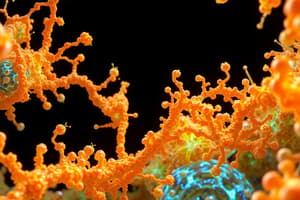Podcast
Questions and Answers
Electron microscopy (EM) has been the standard technique for virus diagnosis throughout the 21st century
Electron microscopy (EM) has been the standard technique for virus diagnosis throughout the 21st century
False (B)
Molecular biology techniques like PCR and ELISA are currently more commonly used than EM for virus identification
Molecular biology techniques like PCR and ELISA are currently more commonly used than EM for virus identification
True (A)
EM is not essential for identifying unknown emerging viruses if primers, antibodies, or probes are available
EM is not essential for identifying unknown emerging viruses if primers, antibodies, or probes are available
False (B)
EM has the potential to detect all viral particles present in a sample, making it a 'catch-all' approach
EM has the potential to detect all viral particles present in a sample, making it a 'catch-all' approach
Cross-linking chemicals are not used in the process of embedding resin-embedded cells for TEM analysis.
Cross-linking chemicals are not used in the process of embedding resin-embedded cells for TEM analysis.
Low viscosity resins are not suitable for immunocytochemistry and correlative light electron microscopy (CLEM) studies.
Low viscosity resins are not suitable for immunocytochemistry and correlative light electron microscopy (CLEM) studies.
Routine ultrathin sections for resin-embedded cells are typically obtained at a thickness of 100-120 nm.
Routine ultrathin sections for resin-embedded cells are typically obtained at a thickness of 100-120 nm.
Frozen-hydrated sections can be analyzed by the so-called cryo-electron microscopy of vitreous sections (CEMOVIS) at temperatures above -150 degrees Celsius.
Frozen-hydrated sections can be analyzed by the so-called cryo-electron microscopy of vitreous sections (CEMOVIS) at temperatures above -150 degrees Celsius.
High pressure freezing (HPF) can increase the vitrification depth up to 200 μm compared to plunge and jet freezing.
High pressure freezing (HPF) can increase the vitrification depth up to 200 μm compared to plunge and jet freezing.
Cells grown on resistant supports like sapphire or aclar discs are required for high pressure freezing.
Cells grown on resistant supports like sapphire or aclar discs are required for high pressure freezing.
Combining chemical and cryo-fixation techniques can result in even better preservation of subcellular structures compared to chemical fixation alone.
Combining chemical and cryo-fixation techniques can result in even better preservation of subcellular structures compared to chemical fixation alone.
Epoxy resins are well compatible for immunocytochemistry due to their fine structural preservation.
Epoxy resins are well compatible for immunocytochemistry due to their fine structural preservation.
Chemical fixation with aldehydes creates non-covalent interactions, destabilizing the biological sample.
Chemical fixation with aldehydes creates non-covalent interactions, destabilizing the biological sample.
Formaldehyde is preferred over glutaraldehyde for chemical fixation due to its superior cross-linking ability.
Formaldehyde is preferred over glutaraldehyde for chemical fixation due to its superior cross-linking ability.
New EM techniques only allow the visualization of cellular structures in 2D and cannot unravel the 3D architecture of cells and virus-infected cells.
New EM techniques only allow the visualization of cellular structures in 2D and cannot unravel the 3D architecture of cells and virus-infected cells.
The nature of the buffer used for routine fixation has no influence on the fixation process.
The nature of the buffer used for routine fixation has no influence on the fixation process.
Frozen cells can be subjected to freeze substitution (FS) or cryo-electron microscopy (cryo-EM) for analysis.
Frozen cells can be subjected to freeze substitution (FS) or cryo-electron microscopy (cryo-EM) for analysis.
Chemical fixation of cells is standardized and does not depend on the specific experimental setup.
Chemical fixation of cells is standardized and does not depend on the specific experimental setup.
Pelleting cells can alter their morphology and lead to artifacts.
Pelleting cells can alter their morphology and lead to artifacts.
Cryo-fixation methods have no depth limitation due to poor heat conductance of water.
Cryo-fixation methods have no depth limitation due to poor heat conductance of water.
Flashcards are hidden until you start studying
Study Notes
- Frozen cells can be subjected to freeze substitution (FS) or cryo-electron microscopy (cryo-EM) for analysis.
- Frozen cells are not processed further, allowing them to be visualized in their closest-to-native state.
- Chemical fixation of cells is not standardized, and optimal conditions depend on the specific experimental setup.
- Consulting an EM specialist or checking the literature is recommended to determine the best fixation conditions.
- Cells can be prepared for EM as monolayers or pellets, with pellets requiring additional processing steps.
- Pelleting cells can alter their morphology and lead to artifacts.
- Chemical fixation alters the cell structure by forming a network of cross-linked molecules, which can cause artifacts.
- Cryo-fixation is an alternative to chemical fixation, which preserves the cell in its native state by vitrifying the water.
- Cryo-fixation methods include plunge freezing and jet freezing, but have a depth limitation due to poor heat conductance of water.
- Pre-incubating samples with cryoprotectants can prevent ice formation but introduce alterations in the original cytoarchitecture.
- Cryo-EM allows visualization of Hepatitis C Virus-induced double membrane vesicles without the artifacts caused by chemical fixation.
Studying That Suits You
Use AI to generate personalized quizzes and flashcards to suit your learning preferences.

